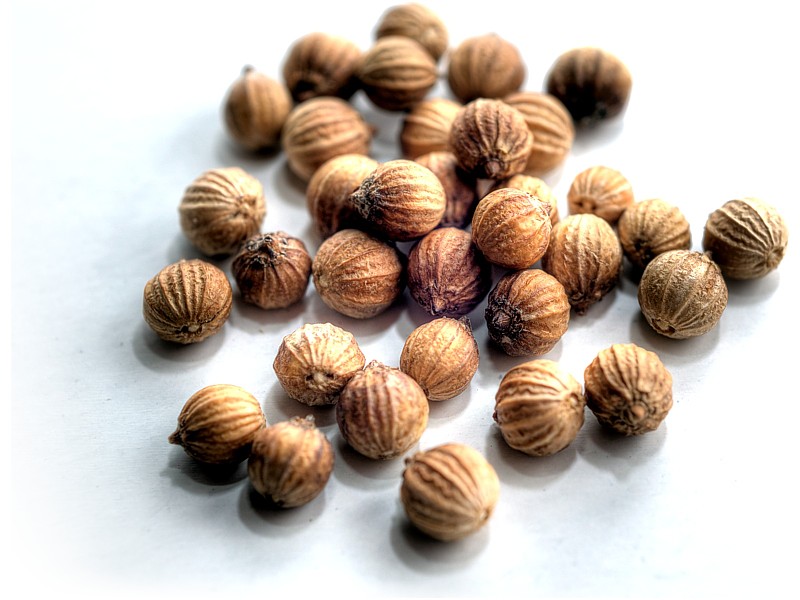| Revision as of 03:35, 24 February 2005 editNovalis (talk | contribs)Extended confirmed users1,463 edits Added photo of coriander seeds← Previous edit | Revision as of 03:45, 24 February 2005 edit undoSebastianHelm (talk | contribs)Administrators21,373 edits →Leaves: moved guacamole to sentence about ingredients. Deleted Latin America, as it is already mentioned in intro.Next edit → | ||
| Line 25: | Line 25: | ||
| The leaves are variously referred to as '''coriander leaves''', '''cilantro''' (in the ], from the Spanish name for the plant), '''dhania''' (in the ], and increasingly, in ]), '''Chinese parsley''' or '''Mexican parsley'''. The leaves have a very different taste from the seeds. They taste soapy to some people. This difference in perception of the flavor of the leaves may have a genetic cause. | The leaves are variously referred to as '''coriander leaves''', '''cilantro''' (in the ], from the Spanish name for the plant), '''dhania''' (in the ], and increasingly, in ]), '''Chinese parsley''' or '''Mexican parsley'''. The leaves have a very different taste from the seeds. They taste soapy to some people. This difference in perception of the flavor of the leaves may have a genetic cause. | ||
| The fresh leaves are an essential ingredient in many Asian ]s and Mexican ]s. Chopped coriander leaves are also used as a garnish on cooked dishes such as ] and many ], but should never themselves be cooked as heat destroys their delicate flavor quickly. | The fresh leaves are an essential ingredient in many Asian ]s and Mexican ]s and ]. Chopped coriander leaves are also used as a garnish on cooked dishes such as ] and many ], but should never themselves be cooked as heat destroys their delicate flavor quickly. | ||
| The fresh herb is best stored in the refrigerator in air tight containers, after chopping off the roots. | The fresh herb is best stored in the refrigerator in air tight containers, after chopping off the roots. | ||
| Cilantro is popular in ], and is an ingredient of the ] ]. | |||
| ==Seeds== | ==Seeds== | ||
Revision as of 03:45, 24 February 2005
| Coriander | ||||||||||||||||
|---|---|---|---|---|---|---|---|---|---|---|---|---|---|---|---|---|
 | ||||||||||||||||
| Scientific classification | ||||||||||||||||
| ||||||||||||||||
| Binomial name | ||||||||||||||||
| Coriandrum sativum |
Coriander (Coriandrum sativum) is an annual herb commonly used in Middle Eastern, Mediterranean, Indian, Latin American and Southeast Asian cooking. All parts of the plant are edible, but the fresh leaves and the dried seeds are the most commonly used in cooking. Coriander belongs to the parsley or carrot family, Apiaceae.
Leaves
The leaves are variously referred to as coriander leaves, cilantro (in the U.S., from the Spanish name for the plant), dhania (in the Indian subcontinent, and increasingly, in Britain), Chinese parsley or Mexican parsley. The leaves have a very different taste from the seeds. They taste soapy to some people. This difference in perception of the flavor of the leaves may have a genetic cause.
The fresh leaves are an essential ingredient in many Asian chutneys and Mexican salsas and guacamole. Chopped coriander leaves are also used as a garnish on cooked dishes such as dal and many curries, but should never themselves be cooked as heat destroys their delicate flavor quickly.
The fresh herb is best stored in the refrigerator in air tight containers, after chopping off the roots.
Seeds

The seeds are known as coriander seeds and have a lemon citrus flavor when crushed. It is also described as warm, nutty, spicy, and orange-flavoured. They are usually dried but can be eaten green. Ground coriander is a major ingredient in curry powder and other aromatic dishes.
If the spice is bought whole in a non-dried form, it can be dried in the sun. Most commonly, it is bought as whole dried seeds, but can be bought in ground form. Store coriander seed in a tightly sealed container away from sunlight and heat. For maximum flavor use within 6 months and keep for no more than 1 year. It can be roasted or heated on a dry pan briefly to enhance the aroma before grinding it in an electric grinder or with a mortar and pestle; ground coriander seeds lose their flavour quickly in storage and are best only ground as needed.
It is a key ingredient in Indian curries and garam masala (Hindi name: dhania). It is also used in Ethiopian and Arabic cooking.
Coriander is also an important spice for sausages in Germany and South Africa (see boerewors).
History
It is believed to have originated in the Mediterranean area, and in Southwest Europe. Some believe its use began as far back as 5,000 BC, and there is evidence of its use by the Egyptians. In the Bible, Exodus, chapter 16, verse 31, it says that: "And the house of Israel called the name there of Manna: and it was like coriander seed, white; and the taste of it was like wafers made with honey". Coriander was brought to the United States of America in 1670 and was one of the first spices cultivated by early settlers.
Coriander seed and leaf was very widely used in medieval European cuisine, due to its ability to make spoiled meats palatable by "masking" rotten flavors. Even today, coriander seed is an important ingredient in many sausage products.
Name
The name coriander, coriandrum, first noted by Pliny, derives from Greek Corys (a bedbug), + -ander (resembling), and refers to the supposed similarity of the scent of the crushed leaves to the distinctive odor of bedbugs (which we have largely forgotten in this age of insecticides).
Other meanings
Coriander is also an open source computer program licenced under the GNU General Public Licence. It is used to capture and control firewire cameras on the Linux Operating System.